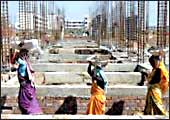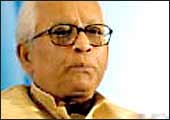| Users
of Google's web-based e-mail service Gmail will swear by it. Despite
its invitation-only status, it became a de facto standard for private
e-mail addresses across the world. Even though it was Sabeer Bhatia's
Hotmail that started the concept of free web-based e-mail, the engineers
at Google realised that with greater bandwidth and heavier file
sizes, people wanted more storage; so on April Fool's Day in 2004,
they launched Gmail with 1 gigabyte of storage and on the same day
next year, they doubled capacity; today, Gmail's storage capacity
stands at over 2.75 gigabytes.
Gmail has worked very effectively for Google despite it almost
donating away massive amounts of storage space (few users, however,
use more than a quarter of their storage) because Google has been
able to weave its revenue generating AdWords contextual advertising
into Gmail.
Other free e-mail providers (such as Yahoo! and Hotmail) have
had problems catching up with Google and not just because of the
storage space. Gmail also has a brilliant spam filter and other
features (integrating RSS feeds, MP3s and images as well as mobile
accessibility and free pop3 services). But these other e-mail
service providers have always had one advantage over Gmail. The
latter was a "by invitation only" service, which meant
that not everyone could sign up for Gmail.
Now, Google has addressed this issue. Anyone visiting the Gmail
homepage can sign up for the service, and with class-leading features,
many people might switch over. Because of the tight integration
of Gmail and AdWords, this decision makes immense business sense
for Google. And take our word for it, Gmail is worth it, even
though it is possibly a critical part in Google's plan to dominate
the internet!
-Kushan Mitra
World
Bank Opens its Purse Strings for India
 |
| Investing in infrastructure: World Bank
scales up its commitment |
As
India struggles to charge up its rural economy and invest in infrastructure,
the World Bank is scaling up its commitments to India. "The
Bank will increase its funding programme in India from an average
of $2.5 billion (Rs 11,000 crore) to $4 billion (Rs 17,600 crore)
over the next two-to-three years. We will especially focus on
strengthening infrastructure, supporting states that are lagging
behind the rest and scaling up service delivery," says Praful
C. Patel, Regional Vice President (South Asia), World Bank.
Some of proposed projects that will benefit from this are the
Andhra Pradesh Urban Reform and Municipal Services Project, the
Bihar Rural Livelihoods Development Project, the National Urban
Renewal Mission, the Coal-fired Power Station Rehabilitation Project,
Delhi Water Supply and Sewerage Project, Gujarat Urban Development
Programme, and the Himachal Pradesh State Roads Project. The enhanced
commitments come at a time when the bank has recognised India's
efforts to improve its business environment.
-Kapil Bajaj
Tensions
Growing Within Left
 |
| Bhattacharjee: Will he survive? |
The
agitations over Singur and Nandigram and the West Bengal government's
handling of the issue have exposed the deep chasms that lie beneath
the monolithic image that the Left has cultivated for itself.
Buddhadeb Bhattacharjee's pro-industry policies have resulted
in even smaller Left partners like the CPI, Forward Bloc and RSP,
hitherto, too timid to speak out against Big Brother CPI(M), coming
out openly against the Chief Minister. The pro-Bhattacharjee camp
in the West Bengal unit of the party feels these parties are being
encouraged by hardliners in Delhi and elsewhere who don't want
to openly take on Bhattacharjee. The cm himself does not deny
differences within the party and with a section leaders in Delhi.
"Debates on important issues are only healthy and natural.
But we are trying to establish a 'consensus' within the party
that will facilitate the implementation of development programmes
connected with contentious issues," he recently told the
media.
Bhattacharjee, who feels he has the people's mandate to carry
forward his version of economic reforms, is increasingly feeling
cornered by the doctrinaire approach of his party's central leadership
and the "armchair" comrades who make up the party's
(fast depleting) numbers outside of West Bengal, Tripura and Kerala.
No one is yet talking of a split in the country's mainstream Left
movement, but party insiders say that senior leaders like Jyoti
Basu and Harkishen Singh Surjeet are working hard behind the scenes
to avert a headlong collision between the hardline central leadership
and the reformist state satraps. "One formula being discussed
is a variation of China's (but of course) 'one country, two systems'
policy," says a senior leader in the West Bengal unit of
the party.
What does this mean for the party, and the UPA government it
supports, at the national level? "A good watchdog growls
but seldom bites," says the leader. That can only be good
news for the government.
-Ritwik Mukherjee
The
Election Effect
How do you know when the government
is moving into election mode? You know it when it suddenly starts
worrying about such mundane things as price rise, farmers' agitations
and middle class anger. With elections due in states like Uttar
Pradesh, Manipur and Uttaranchal, it is little wonder that the
UPA government has woken up, albeit late, to the inflation rate,
which touched 6.73 per cent in the third week of February. The
Congress, stung by the recent reverse in the Mumbai municipal
elections, and expecting to fare badly in Punjab, was quick to
react. It cut prices of petrol and diesel by Rs 2 and Re 1, respectively.
UPA Chairperson and Congress President Sonia Gandhi shot off
a letter to Prime Minister Manmohan Singh asking him to go slow
on allowing multinational retail majors like Wal-Mart and Tesco
access to the Indian market. She also asked the government to
halt the acquisition of farmlands for SEZs. "The letter seeks
appropriate safeguards and measures to ensure that the aam admi
is not prejudiced by such economic activities," says a Congress
spokesperson.
The Left parties, expectedly, are taking credit for this "pro-people"
intervention, even though they are surprised by its timing. "We
gave her a note on the subject in 2005; it's very strange that
she has suddenly written this letter," says CPI(M) MP Nilotpal
Basu. It isn't really strange. He just needs to consult his election
calendar to know why.
-Amit Mukherjee
It's
Now BRIC vs BRIC
When Goldman Sachs coined the word
BRIC (Brazil, Russia, India and China) in 2003, the world sat
up and began to look at these countries in a new light. Since
then, the BRIC nations have largely followed the script, dutifully
recording high growth rates, attracting ever increasing foreign
direct investment inflows and featuring on the front pages and
covers of the world's leading publications.
Now, the script has taken an interesting turn. The BRIC nations,
it seems, are competing furiously among themselves to acquire
primary industrial and energy assets across the world. When Tata
Steel announced its bid for European steelmaker Corus, it attracted
a counter-offer from Brazilian steel company CSN. The auction
that finally settled the issue in favour of the Tatas resulted
in the final price escalating by 34 per cent over the original
offer.
Says R.K. Agrawal, Director, Ernst & Young: "Yes, it
is, indeed, a fact that the race to acquire overseas assets is
hotting up and that BRIC countries are now competing among themselves
in quite a number of cases." Sure enough, within days of
Kumar Mangalam Birla announcing his $6 billion (Rs 26,400 crore)
bid to take over Canadian aluminium company Novelis, there are
sporadic reports of Russian Aluminium Company (RUSAL) considering
a counter-offer. "I have no doubt whatsoever that the trend
of companies from BRIC countries taking on each other for overseas
acquisitions will continue in the years to come," says Sanjiv
Goenka, Vice Chairman of RPG Enterprises and former President
of CII. But, says Agrawal: "The successes of the Tatas, and
L.N. Mittal before them, have given Indian companies the courage
and confidence to take on a win against all comers."
One sector where Indian companies have been beaten comprehensively
by their Chinese counterparts is oil. The China National Petroleum
Company has routinely trumped ONGC Videsh's (OVL's) attempts to
establish beachheads in the oil rich countries of Central Asia
and parts of Africa. Whenever OVL came close to a deal, it found
itself pipped at the post by a combination of aid and diplomacy
launched by China.
So, are more such tussles likely in future? Watch this space.
-Ritwik Mukherjee
UBS
EYES LARGER ROLE IN INDIA
 |
| Eyeing India: UBS Bank's Jenkins |
UBS investment bank is aggressively
eyeing the Indian market. It has already marked its presence in
the M&A segment by partially funding two major deals-Vodafone's
$11.1 billion (Rs 48,840 crore) acquisition of Hutchison Essar
and Hindalco's still pending $6 billion (Rs 26,400 crore) buyout
of Novelis. "We see a tremendously increased appetite in
India for mergers and acquisitions, and that is why we want to
rapidly ramp up our presence here," says Huw Jenkins, Chairman
and CEO, UBS Investment Bank, who was in India recently.
The company has acquired Standard Chartered Bank's asset management
company in India, and it is also considering expanding its existing
offshoring business here. "We are also keen on setting up
a branch of our bank here," he says, adding that UBS has
been trying to get a clearance for the licence, application which
is now pending for more than two years.
UBS feels Indian companies should look at West Asia for opportunities
in the infrastructure, steel smelting and hydrocarbon sectors.
"We can play a large role advising Indian companies on these
and also help fund deals that materialise," he says.
The group also has a 2,000-seat offshoring centre in Hyderabad.
"We want to expand this to world-class levels," Jenkins
adds, but declines to get into specifics about numbers.
-Amit Mukherjee
|








